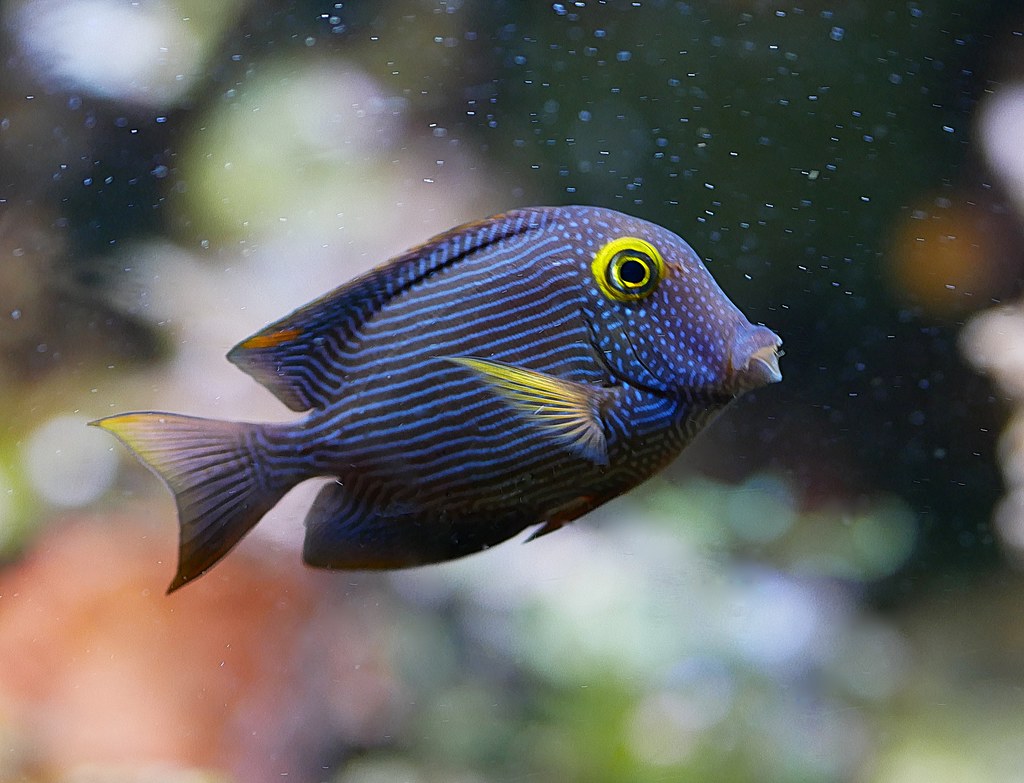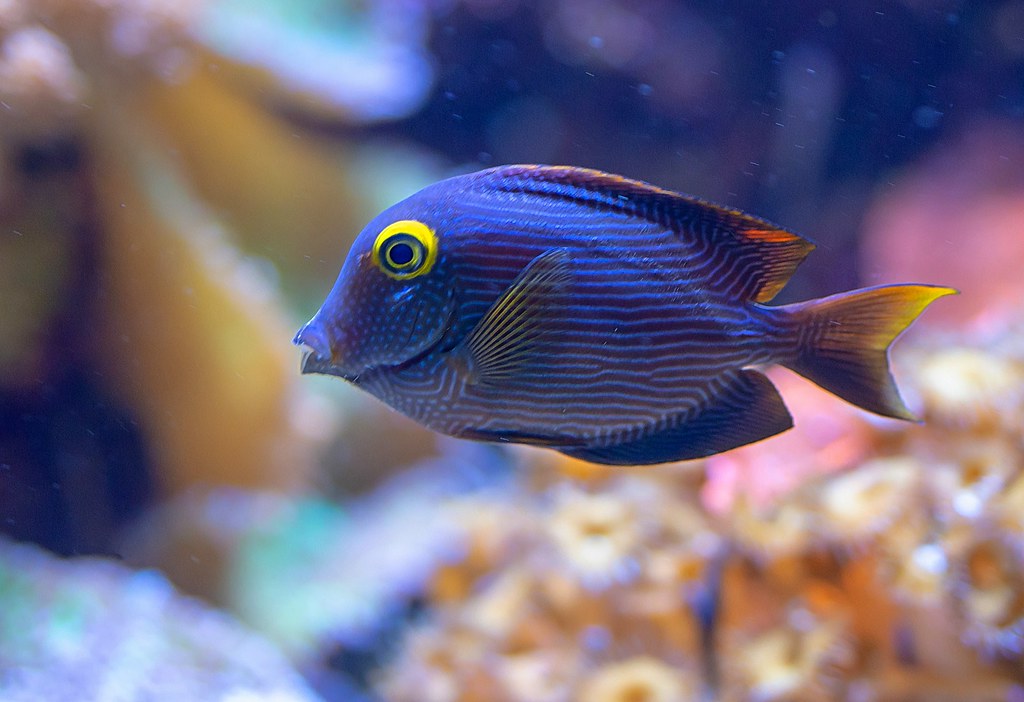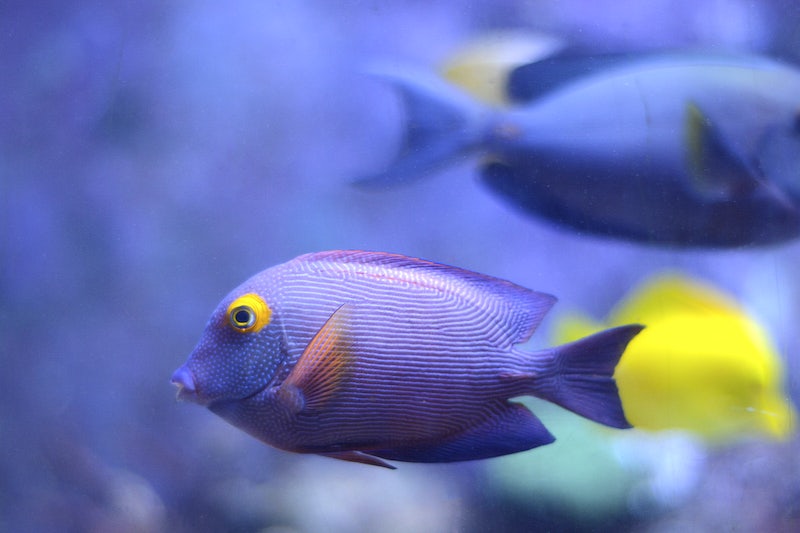Kole Yellow Eye Tang: Care, Growth Rate, Diet & More
Posted by Miles Harrison on 09/20/2022
We use affiliate links and may receive a small commission on purchases.
Occasionally referred to as Doctorfish or Surgeonfish, Tangs are some of the most popular types of saltwater aquarium fish available in the hobby. Certain species, such as the Pacific Blue Tang, are so popular they’ve graced the big screen in major Hollywood films.
One of the lesser-known species is the Kole Yellow Eye Tang. Native to Oceania, this species dazzles with its horizontal stripes and brown or purplish color, making it a sought-after species in reef keeping.
In this post, we’ll discuss care, diet, and even breeding to ensure that you have all of the knowledge needed to care for this unique and interesting species.
January's Giveaways on Light Fish
Species Summary
Kole Yellow Eye Tangs have received a variety of different names throughout their existence in the aquarium hobby. These fish are occasionally referred to as Spotted Surgeonfish, Goldring Surgeonfish, Striped Bristletooth, Bristletooth Tang, or simply Kole Tangs.
In their native habitat, these fish can be found swimming throughout shallow reefs in Oceania, the geographic region that includes Melanesia, Polynesia, Micronesia, and Australasia. These herbivores can be seen cleaning the shells of sea turtles, which often have a layer of nutritious algae for the tang to feed off of.

Kole Yellow Eye Tang Lifespan
In an aquarium, the Kole Yellow Eye Tang can live for an astonishing 25 years. In their natural environment, these fish have been known to live for up to 35 years.
As with almost all other species, the lifespan of a Kole Yellow Eye Tang depends on the care received. Feeding this fish a proper diet, maintaining excellent water conditions, and providing ample space for this fish to swim will result in a healthy life expectancy.
What does the Kole Yellow Eye Tang look like?
Kole Yellow Eye Tangs have a unique appearance. Their most prominent feature is the yellow ring that surrounds their eye, and the eye itself is surrounded by a smaller blue ring. This species also displays many horizontal stripes over its metallic-brown or purple body. The face of the fish features a large amount of small dots that match the color of the horizontal stripes.
These fish have oval-shaped bodies, and their pectoral fins tend to have an orange/yellowish hue. Their tails often have a similar hue, and a continuous dorsal fin is located on the top of the fish. One of the most distinct aspects of all tangs, including the Kole Yellow Eye Tang, is its spine, located before the tail fin. This spine acts similar to a small blade, which can be raised out of a groove inside of the body when the fish is threatened. The fish will demonstrate a slashing motion to inflict a wound using this spine on a potential predator.
These fish are very chromatic and are capable of performing subtle variations in color. Juveniles and adults differ in appearance, with light intensity being the number one factor in coloration. Interestingly, given blue lighting, the horizontal lines will give off a more blue appearance.
Kole Yellow Eye Tang Size
While some tang fish can grow quite large, the Kole Yellow Eye Tang only grows to be about 7 inches in length. Aquarists will be happy knowing that these fish can be kept in smaller aquariums compared to other types of surgeonfish.
Kole Yellow Eye Tang Care
Although some species of tang can have complex care requirements, the Kole Yellow Eye Tang is considered an intermediate fish for most aquarists. These fish are known to be quite hardy and can tolerate the occasional swing in water chemistry as long as they are within reason.
These fish, similar to their native habitat, prefer a sand substrate, temperatures between 72°-79°, and specific gravity levels between 1.023-1.025. You’ll want to provide plenty of live rock for algae to grow. These fish are herbivores and will consume the algae as a food source. These fish are active swimmers, similar to the Snowflake Clownfish, and will appreciate large open areas in the aquarium and plenty of currents to swim against.
These fish will appreciate bi-weekly 20% water changes, and a mature aquarium of at least 9 months to ensure that algae growth is present. Poor diets are often correlated to a loss in color with this species.
Common Diseases
White Ich
Kole Yellow Eye Tangs face many of the same diseases that challenge marine fish owners. One of the most common diseases is Cryptocaryon irritans, also known as “Saltwater ich” or “White spot disease”. This disease is usually associated with sudden changes in water temperature, exposure to high levels of ammonia, nitrite, nitrate, and even overcrowding can contribute to the onset of this disease.
White Ich Cure
One of the best ways to cure this common disease is through a method called Hyposalinity. You’ll want to hold salinity levels at 11ppt to 12ppt for 4 weeks (roughly 1.008-1.009g). After this 4-week period ends, slowly raise the salinity levels over an additional 4-week period, and observe the fish for stress. This is the least stressful method when it comes to curing marine fish diagnosed with ick.
Another cure often recommended by aquarists is treating the aquarium with copper. Products like Mardel Coppersafe will cure ick if the instructions are followed correctly. However, it is worth noting that copper is poisonous to fish, so this method should be used with caution.
Last, you can try the quarantine method, which involves repeatedly transferring the infected fish to hospital tanks until the disease disappears. This is very time-consuming and resource-intensive, and fish will suffer from having to adapt to each hospital tank. However, it has proven to be an effective treatment.
Black spot disease
Also known as "Tang disease", black spot disease is a parasitic infestation caused by a flatworm species. As you can probably guess, the primary symptom of this disease is black spots appearing on the body of the tang. Uncommon in home aquariums, it’s thought that this disease may be transferred to new aquariums after the addition of new livestock.
Black spot disease cure
You’ll need to ensure all of the parasitic worms are fully removed. These worms have been known to last months in an aquarium without a host, so you’ll need to eliminate them to prevent re-infection.
You’ll want to vacuum your substrate to remove any potential worm eggs. Bristle worms, brittle stars, and other invertebrates are also known to consume these worm eggs. Any fish that have been affected by these worms will need to be removed from the aquarium, dipped in malachite green, and then methylene blue. After they’ve been dipped, they should be transferred into a quarantine tank for 3-4 weeks. After this period, you should be able to re-introduce the fish into your aquarium. Repeat these steps for any other infected fish.
Setting up an aquarium for a Kole Yellow Eye Tang
Before adding a new Kole Yellow Eye Tang to your reef tank, you’ll want to make sure you have everything in place to ensure the Tang will live a healthy and happy life. Kole Yellow Eye Tangs should be added to a mature aquarium, we recommend one that’s been fully established for at least 6 months. If you can consistently keep water parameters stable without any swings, you’ll be able to keep this species.

You’ll want to be sure you have an aquarium that’s at least 70 gallons in size, and that there should be no other Tang fish. Kole Yellow Eye Tangs will show aggression towards other Tangs.
These fish prefer a sand substrate, with lots of live rock for algae to grow on. Kole Yellow Eye Tangs are native to Oceania, where temperatures range from 75-82°, so you will want to maintain similar temperatures in your reef tank.
Known as reef-safe fish, these fish are fully compatible with corals, and will often swim around investigating the coral for any available algae.
Now let’s discuss live rock. Since these fish are algae-eaters, you’ll want to provide a substantial amount of live rock in your reef tank. However, you’ll need to keep in mind that Tangs love open spaces to swim in. Make sure that there is still a large amount of open space for the Kole Yellow Eye tang to swim through.
Luckily, Tangs are not known to jump out of aquariums. That being said, it is still possible, as any fish may accidentally take a leap of faith. To avoid this scenario, we recommended having a lid on top of the tank. Applying a tight-fitting lid will ensure that all of your fish remain in your aquarium.
Water Chemistry
Kole Yellow Eye Tangs will thrive in these conditions:
Alkalinity: 8-12dkh
Calcium: 350-450ppm
Phosphate: <= .3ppm
Ammonia: 0ppm
Nitrite: 0ppm
Nitrate: <5ppm
PH: 8.1-8.4
Specific Gravity: 1.023-1.025
Temperature: 78-80°F (25-27°C)
We recommend having these conditions before introducing a Kole Yellow Eye Tang, as they are ideal parameters for any reef tank.
Now, let’s discuss tank decorations. Betta fish can be startled quite easily, so you’ll want to provide plenty of hiding spots for your betta fish.
Equipment
Having the right equipment in a saltwater aquarium is crucial in maintaining balanced water chemistry levels. Since the Kole Yellow Eye Tang requires such a large aquarium, you’ll need a powerful filter to turn over the water.
We recommend filters such as the Fluval 07 series, or the Eheim Pro 4+ 350. Both Eheim and Fluval have a reputation for selling reliable aquarium equipment.
Kole Yellow Eyes occasionally enjoy swimming against a current, so including powerheads such as ones from brands like EcoTech Marine, will be beneficial for the development of this species.
Food and diet info
Hobbyists will be pleased to know that the Kole Yellow Eye Tang accepts a variety of different types of tank foods. Algae-based flake foods, dried shrimp, and bloodworms will all be accepted by this Tang. Even dried seafood will be enjoyed by this species.
These fish are some of the best algae-eating fish available in the saltwater aquarium hobby, where they will use their bristle teeth to consume diatoms and detritus along the substrate.
These fish should be fed daily, and at a minimum at least 3 times a week, depending on how much algae is available in the tank. Providing a suitable diet will strengthen this fish’s immune system, in turn preventing them from getting some of the common diseases.
Although we don’t recommend excessive amounts of food, aquarists will be pleased to know that it’s nearly impossible to overfeed a Tang. In the wild, these fish can become quite fat!
Behavior & temperament
Given the correct environment, Kole Yellow Eye Tangs have great personalities. These fish are very active, and will constantly swim around the aquarium in search of algae to graze on. With their huge appetites, these fish will eat almost anything. It’s quite entertaining to watch an overfed Kole Yellow swimming happily throughout an established reef tank!
These fish have a unique temperament. Some aquarists have reported that these will fish occasionally show aggression towards any new fish, but for the most part, if this is the only tang fish in an aquarium, it will get along with many other types of saltwater fish.
It’s important to ensure that this fish is the only tang in the aquarium. As with almost all tang species, the Kole Yellow Eye will show signs of aggressive behavior towards other Tangs. Signs of aggression include chasing, flaring fins, circling each other, and swiping motions that are used to display dominance. Interestingly, Kole Yellow Eye Tangs have been known to show increasing signs of aggression relative to their size, with larger tangs showing more aggressive behavior.
Tank mates
As previously mentioned, it’s important to make sure that the Kole Yellow Eye Tang is the only tang fish in a saltwater aquarium. That being said, this fish can get along quite well with most other species.
The most important factor to consider when adding new tank mates is aquarium size. Fish will show signs of aggression when aquariums are overstocked and compatibility issues arise.
Having an established aquarium that provides plenty of room for fish to swim, and plenty of hiding spots for inhabitants to hide in is ideal for this tang species.
So which tank mates are compatible with a Kole Yellow Eye Tang? Flame angels, Mandarinfish, Common Clownfish, Foxface Rabbitfish, and Tailspot Blennies will all do well with a Kole Yellow Eye Tang. Kole Yellows are invert-safe, so you should have no problem adding this species to an aquarium with Cleaner Shrimp or Thor amboinensis (also known as Sexy shrimp.)

Breeding the Kole Yellow Eye Tang: Is it possible?
Known as egg scatterers that spawn in particular locations as a group, there have been no success stories when it comes to breeding this fish in captivity. Luckily, one day we might see this fish in captivity. Recent breakthroughs due to research done by the Oceanic Institute in Hawaii, have made it possible for Yellow Tangs to be bred successfully. The Yellow Tang was once considered impossible to breed, so there is hope for future captive-bred Kole Yellow Eye Tangs.
Where can I buy a Kole Yellow Eye tang?
These fish are relatively uncommon, hobbyists will be lucky to locate this species at a local fish store, or an online marketplace such as Light Fish.
In Summary
When it comes to must-have saltwater aquarium fish, the Kole Yellow Eye tang is high on our list. Although you most likely will only be able to house one type of tang species, the Kole Yellow Eye is just as eye-catching as other popular tangs such as the Powder Blue.
Known for its algae-grazing abilities, this fish will surely catch the attention of anyone fortunate enough to view it in an at-home aquarium.
The Kole Yellow Eye Tang is one of our favorite fish, and we strongly recommend this species to any saltwater hobbyist considering a Tang fish!
January's Giveaways on Light Fish


